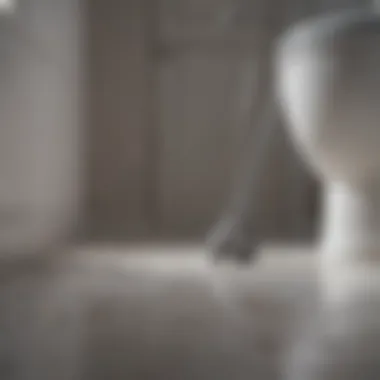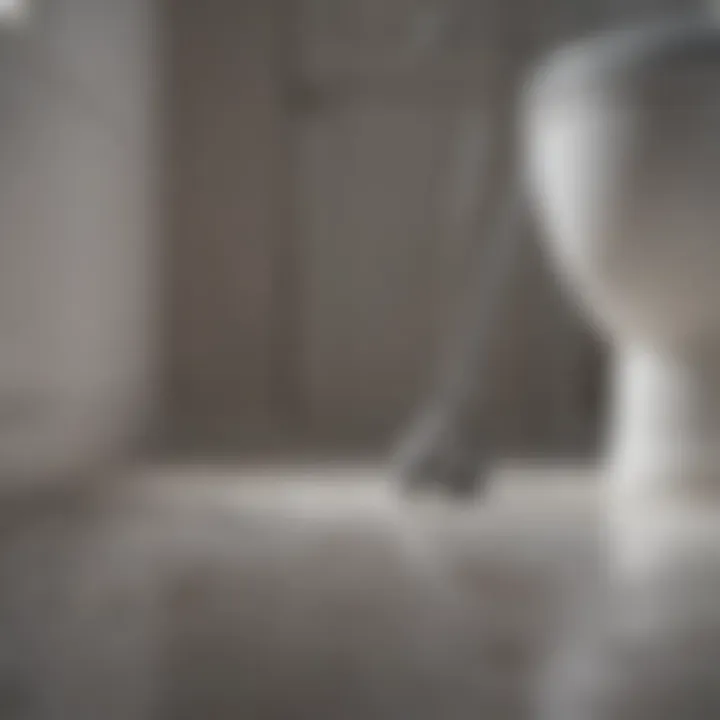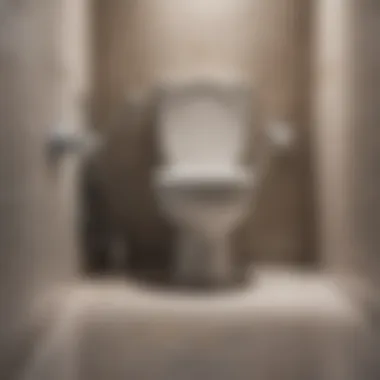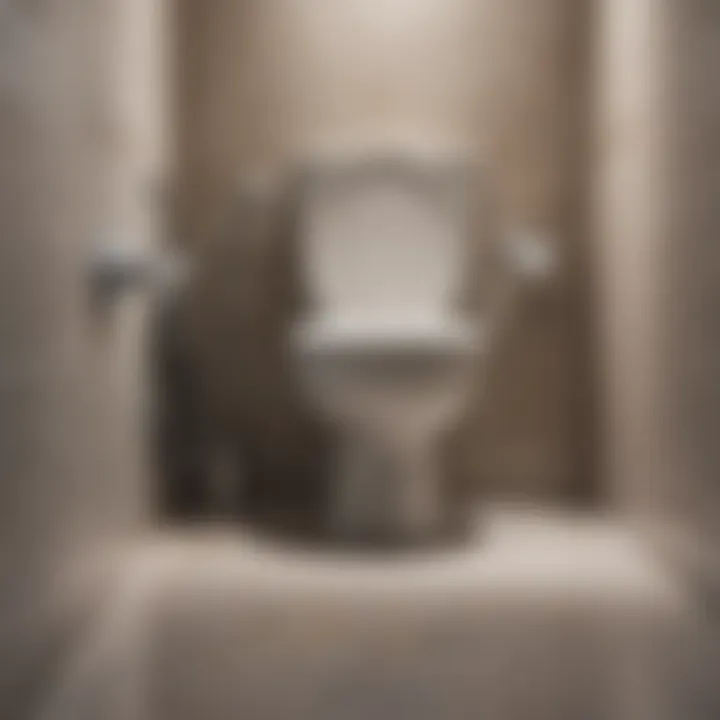Mastering the Art of Draining a Toilet Bowl Efficiently


Intro
Draining a toilet bowl may seem like a simple task, but it requires a methodical approach to ensure efficiency and effectiveness. Whether it's for maintenance, repairs, or addressing an emergency, understanding the proper techniques can make a significant difference. This guide will outline a range of methods to drain a toilet bowl, delve into necessary tools, elaborate on safety precautions, and provide troubleshooting tips for common problems.
By mastering these skills, you can handle basic plumbing tasks more confidently and proficiently. This is particularly useful for homeowners and those who enjoy DIY home improvement projects.
Understanding the Importance of Draining a Toilet Bowl
Draining a toilet bowl serves many purposes. First, it can help resolve clogs that lead to inconvenient overflows. Second, it is essential when you need to remove and replace your toilet, facilitating a smoother process. Plus, routine draining can contribute to preventative maintenance by allowing you to check for leaks.
Methods to Drain a Toilet Bowl
There are several effective methods to accomplish this task, each with its own set of advantages. Understanding when and how to use each approach can significantly enhance the outcome. Here are the most practical methods:
- Manual Flush: A manual flush can be employed in many cases, particularly when dealing with minor clogs.
- Using a Plunger: A high-quality toilet plunger can help dislodge clogs that make draining difficult.
- Wet/Dry Vacuum: This tool is especially useful when you need to remove a large volume of water quickly.
- Chemical Drain Cleaners: In some scenarios, specific chemical solutions can break down more stubborn blockages, allowing the water to drain effectively.
Tools You Will Need
Before attempting to drain the toilet bowl, it's helpful to gather a few essential tools. This preparation will minimize hassle during the process. Necessary items include:
- Rubber gloves
- Plunger
- Wet/dry vacuum
- Towels or rags
- Bucket
Safety Precautions
Working with plumbing can be challenging, and safety should be a top concern. Here are some critical precautions to follow:
- Wear rubber gloves to protect your hands from germs.
- Ensure proper ventilation when using chemical drain cleaners to avoid inhalation of harmful fumes.
- Shut off the water supply to your toilet to prevent unexpected spills.
"Proper preparation and safety measures lead to successful toilet maintenance."
Troubleshooting Common Problems
Sometimes, issues can arise even after draining the toilet bowl. Being prepared can help save time and frustration. Here are some common problems and their solutions:
- Persistent clogs: Try using a more powerful plunger or invite a plumber if the clog does not budge.
- Leaks: Inspect connections and seals if water pools around the toilet base after draining.
Finale
Preamble to Toilet Drainage
Draining a toilet bowl might seem like a simple task, but its importance cannot be underestimated. Understanding the drainage process is crucial not just for maintenance but also for preventing plumbing issues and managing sanitary conditions in the home. This guide will unveil the intricacies involved in effectively draining a toilet bowl. It will detail methods, the necessary tools, and safety precautions one must consider before beginning.
Understanding Toilet Mechanics
To fully grasp the strategies for draining a toilet bowl, one must first understand how toilets work. Toilets operate based on a few key components: the bowl, the tank, and the flushing mechanism. When you flush, water from the tank rushes into the bowl, creating a siphoning effect that pulls waste away through the drain. This mechanical process ensures a clean bowl after each use. Moreover, toilets are designed to retain enough water in the bowl to maintain a seal, which prevents sewer gases from entering the home. Understanding these elements allows for more informed decisions when issues arise.
Reasons to Drain a Toilet Bowl
There are several compelling reasons to drain a toilet bowl. These include:
- Repairs and Maintenance: Draining may be necessary when fixing or replacing parts, such as the flapper or the fill valve.
- Clog Removal: If a toilet is clogged, draining it can make it easier to address the blockage.
- Cleaning: For deep cleaning, emptying the bowl might be necessary to scrub effectively.
- Storing Toilets: If relocating a toilet or during extended periods of non-use, draining helps prevent stagnant water or potential odors.
By comprehending these factors, homeowners can make better choices concerning their plumbing systems and hygiene. Accurate methods of toilet bowl drainage contribute to efficient household maintenance.
Tools and Materials Required
The section on tools and materials required for draining a toilet bowl plays a crucial role in ensuring a smooth and effective process. Having the right equipment not only increases efficiency but also reduces the risk of making the problem worse. When a toilet needs to be drained, the right tools can make all the difference between a frustrating experience and a quick resolution. Therefore, understanding what tools are necessary, as well as their specific functions and benefits, is essential.
Essential Tools for the Task
Plunger


A plunger is one of the most fundamental tools for draining a toilet bowl. Its primary purpose is to clear clogs and facilitate the flow of water through the pipes. A plunger works by creating a vacuum effect, which actually helps dislodge blockages. The key characteristic of a plunger is its rubber suction cup that adheres to the toilet bowl surface.
This tool is popular due to its simplicity and effectiveness. It does not require any special skills to use, making it accessible for most homeowners. However, it does have limitations. A plunger may not work effectively if the clog is too deep or severe. In such cases, other methods may need to be employed.
Siphoning Kit
A siphoning kit is another valuable tool for draining a toilet bowl. This kit typically includes a hose and a reservoir, allowing for controlled water removal from the toilet. The essential feature of this tool is its ability to create a siphon effect, which can efficiently pull water out without the need for excessive manual effort.
The siphoning kit can be seen as beneficial for individuals seeking a cleaner method of draining. It minimizes the mess often associated with using a bucket or plunger. However, a siphon can be more complex to set up compared to simpler tools. As such, it may not be the first choice for those unfamiliar with its operation.
Buckets
Buckets serve as a practical solution in the draining process. They help collect water that is manually bailed out of the toilet bowl. A bucket's main advantage is its versatility; it can be used for multiple purposes in home maintenance beyond just toilet drainage.
The key feature here is the capacity of the bucket, which allows for holding a significant amount of water at once. This makes it easier to manage larger amounts of liquid as they are removed from the toilet. However, it does require physical effort to scoop the water out, which can be tiring during prolonged use.
Safety Gear Considerations
In addition to tools, wearing appropriate safety gear is critical when draining a toilet. It protects the individual from potential hazards and ensures a clean working environment.
Gloves
Wearing gloves is essential during this process. They provide a barrier between the skin and any harmful bacteria or chemicals that might be present in toilet water. A key characteristic of gloves suitable for this task is their durability and ability to resist tearing at the seams.
Gloves are a beneficial choice because they allow for easier handling of tools and materials without direct contact. However, it's important to select quality gloves, as those that are too thin can lead to tears.
Protective Eyewear
Protective eyewear serves as a pragmatic safety measure. During the draining process, splashes are possible, which could irritate eyes or cause injury. The key characteristic of protective eyewear is its ability to offer coverage while remaining comfortable to wear.
Investing in protective eyewear is advisable as it offers peace of mind, especially for those unfamiliar with the process. One disadvantage may be discomfort if worn for extended periods, which could hinder concentration.
By equipping oneself with the right tools and safety gear, the unpleasant tasks associated with draining a toilet bowl become manageable.
Preparation Steps Before Draining
Proper preparation is critical when it comes to draining a toilet bowl. This step ensures that you minimize messes and accidents during the process. By following the correct preparation techniques, you can enhance your efficiency and effectiveness while safeguarding both the toilet and yourself.
Turning Off the Water Supply
The first step in draining a toilet bowl is to turn off the water supply. This is vital to prevent any unnecessary overflow or flooding. To do this, locate the shutoff valve, typically situated behind the toilet near the wall. Turn the valve clockwise until it stops. By shutting off the water, you also avoid the risk of the tank refilling while you are working.
It can be useful to double-check that the water is off by flushing the toilet. Watch for the bowl and tank to empty, confirming your preparation is successful. If you neglect this step, any attempts to drain the toilet bowl could result in a chaotic situation and unnecessary work.
Emptying the Tank
Next, you need to empty the tank. This is crucial because a full tank will obstruct the draining process and could lead to complications. Once the water supply is off, flush the toilet to remove as much water from the tank as possible. Still, some residual water may remain.
To remove this, you can utilize a sponge or a vacuum designed for liquids. Wipe out any water left in the tank thoroughly. It is helpful to have a bucket nearby for any sponge wring-off. Removing water from the tank prepares the bowl for draining significantly and keeps the workspace clean.
"A tidy workspace leads to a smooth workflow."
Overall, these preparation steps are essential for a successful draining operation. They minimize potential issues and allow you to focus on the draining methods effectively.
Methods to Drain a Toilet Bowl
Draining a toilet bowl is an essential concept in household maintenance. It is not merely about removing water; it serves various practical purposes including repair work, routine cleaning, and ensuring a functioning plumbing system. Understanding how to efficiently drain a toilet bowl aligns with the need for effective home management. The methods of draining a toilet can differ significantly based on the situation encountered. A thorough understanding of these techniques can promote better plumbing health and prevent future issues.
Using a Plunger
Using a plunger is often the first line of defense when dealing with water in a toilet bowl. The operation of a plunger is straightforward, yet it requires correct technique. A cup-style plunger is typically the most effective for toilets. To start, ensure there is enough water in the bowl to cover the plunger's cup. Place the plunger directly over the drain hole and push downward with force. The suction created will either clear a minor blockage or expel excess water. Should the water level be excessively high, remove some water beforehand to avoid overflow, which underscores the importance of preparation.
Employing a Siphon


Employing a siphon is another method to drain a toilet bowl, especially when a more controlled water removal is needed. A siphon kit works by creating a vacuum, drawing water from the bowl into a bucket. To use this technique, insert one end of the siphon hose into the toilet bowl and the other into a provider bucket. Begin siphoning by sucking air from the hose until water starts flowing. This method is particularly useful when you want to avoid using a plunger, as it minimizes splashes and mess. Pay attention to the depth of the hose in the bowl to ensure it reaches the desired water level.
Manual Water Removal
Manual water removal involves using a bucket or sponge to reduce the water level directly. This method is often slower and more labor-intensive than the others but can be effective in properly draining the toilet. Begin by scooping water out of the bowl using a container or a sponge soaked in a bucket. Once the water is sufficiently lowered, cleaning or repairs can be easier. Though time-consuming, this method allows for clear visibility of the toilet's interior, which is helpful when inspecting for any potential issues, such as cracks or blockages.
Creating a Drain Loop
Creating a drain loop is a lesser-known technique that can be beneficial in specific scenarios. This method involves attaching a hose to the toilet drain and gravity to create a loop that allows the water to flow out naturally. Ensure one end is positioned lower than the bowl to facilitate drainage. However, this method may require some plumbing knowledge and should be approached with caution, as improper setup could lead to more complicated drainage problems. Even so, with the right approach, it can be a straightforward solution for ongoing water issues in the toilet.
Proper knowledge of these methods greatly enhances your ability to maintain and troubleshoot your plumbing without the immediate need for professional intervention.
Common Challenges During the Process
Draining a toilet bowl can often present unforeseen challenges. Understanding these challenges prepares individuals to handle them effectively and ensures a smooth process. Tackling potential problems enhances efficiency and minimizes the risk of complications. It is the aim of this section to explore typical obstacles encountered when draining a toilet bowl and to offer practical solutions.
Dealing with Clogs
Clogs are one of the most common issues when attempting to drain a toilet. They can occur due to a buildup of materials such as toilet paper, foreign objects, or even mineral deposits from hard water. Recognizing the signs of a clog early can save you time and effort.
To address a clog, begin by assessing the situation. If water rises dangerously high upon flushing, do not panic. Instead, use a plunger, ensuring you create a tight seal over the drain. This action generates pressure that can dislodge the clog.
If manual plunging does not work, consider employing a snake tool. A snake can break up or retrieve stubborn clogs. Slowly insert it into the toilet drain, turning the handle as it goes deeper until you feel resistance. This method often helps in effective removal of obstruction.
Always remember: Be cautious with the items you flush down; it is far easier to prevent clogs than to deal with them later.
Handling Overflow
Overflow situations can arise from various reasons, including improper flushing techniques or malfunctioning toilet components. These events can cause water to spill onto the bathroom floor, creating a mess and potentially leading to water damage. Therefore, understanding how to manage overflow is crucial for any homeowner.
First, if an overflow is imminent, act quickly. Immediate action can stop a minor issue from turning into a significant problem. Locate the toilet’s water supply valve. This is usually at the wall behind the toilet. Shut off the water supply to halt further flooding.
After stopping the water flow, clean up the area to prevent damage or mold growth. You might need towels or a mop for water removal.
Lastly, evaluate the cause. If this happens frequently, consider inspecting float mechanisms or flappers in the tank for malfunction. Replacing defective parts promptly can prevent further issues. Regular maintenance of the toilet also helps mitigate such incidents.
Post-Draining Steps
After successfully draining the toilet bowl, it's vital to follow certain post-draining steps. These steps ensure that the toilet remains functional, and any potential issues are addressed promptly. By focusing on these elements, homeowners can maintain their plumbing systems effectively, preserving their investment in home infrastructure.
Flushing the System
Once the toilet bowl has been drained, flushing the system becomes the next critical step. This process involves allowing the tank to refill and then flushing the toilet again. This action can help in verifying that the mechanism is working properly and that no residual water remains in the bowl. Flushing also clears away any debris that may have been disturbed during the draining process.
It is recommended to observe the water flow. If the flush is weak or irregular, this may indicate a problem with the flapper valve or the fill valve. Addressing this issue promptly can help prevent further complications. Regular flushing helps to keep the plumbing clean and functioning efficiently, reducing the risk of clogs and buildup over time.
Inspecting for Leaks
After flushing, it is important to inspect the toilet for leaks. Any leaking can lead to water wastage and increased utility bills. Signs of leaks may include water pooling around the base of the toilet or moisture in the tank area. To carry out this inspection:
- Check the Base: Look for any water on the floor surrounding the toilet.
- Examine the Connections: Inspect the water supply line and the connection to the tank for signs of leaks.
- Inspect the Flapper: A faulty flapper can cause water to leak from the tank into the bowl continuously. Check if it is sealing correctly.
Should any leaks be detected, it is wise to address them immediately. Small leaks might be easily fixed by tightening connections or replacing washers. In more severe cases, professional assistance may be necessary.
Restoring Water Supply
Finally, restoring the water supply is the last step in the post-draining process. Once everything has been checked and any possible leaks dealt with, turn the water supply back on. It is crucial to do this slowly to avoid sudden pressure changes that could impact the plumbing system.
After restoring the water supply, monitor the toilet to ensure that the tank fills correctly and there are no leaks. Flush the toilet a few times to test the system under normal operating conditions. Make sure there’s no gurgling or irregular noises, which can indicate further issues.
Restoring the water supply at the right moment after completing these checks maintains toilet functionality and helps keep the plumbing system in check. Regular maintenance, including these post-draining steps, contributes to long-lasting and efficient household plumbing.


Maintenance Tips for Toilets
Toilet maintenance is a critical aspect of home plumbing. Ignoring it can lead to persistent problems such as leaks, clogs, and inefficient flushing. Regular care prevents small issues from escalating into major repairs, which can be costly and time-consuming. By prioritizing maintenance, you ensure the longevity of your toilet and its efficient operation.
Regular Inspection
Conducting regular inspections of your toilet can save homeowners a lot of trouble. At minimum, check for any signs of leaks around the base of the toilet or the tank. A small leak may seem harmless but can cause water loss and damage to flooring over time. The flapper valve in the tank should also be assessed periodically. This component controls water flow during flushing; if it malfunctions, it can lead to water running continuously, thus increasing your water bill unexpectedly.
Additionally, inspect the toilet’s bowl for any stains or mineral buildup. This residue can impact the toilet’s functionality and aesthetic. Cleaning these areas not only keeps the toilet looking appealing but also ensures that the hydraulic components are functioning well.
To make it easier, create a checklist for the inspection process. Include tasks like:
- Checking for leaks
- Inspecting flush mechanisms
- Examining seals and gaskets
- Identifying mineral buildup
Preventative Care Methods
Preventative care methods enhance the toilet’s performance and minimize maintenance needs. Simple practices such as regular cleaning can prevent mineral deposits from forming. Use suitable cleaning agents designed for toilets to keep the bowl clean and prevent staining.
Another method is to address small plumbing issues immediately rather than postponing repairs. For instance, if the toilet handle sticks or seems tough to operate, consider inspecting the internal components right away. This can prevent further wear and subsequent issues like a broken handle or tank component.
You might also want to periodically add products designed for toilet maintenance. These can be used to reduce the buildup of minerals and bacteria in the bowl and tank. Be mindful to choose eco-friendly options that are also safe for plumbing systems.
Furthermore, familiarize yourself with your toilet's model. Understanding its specific requirements can provide insights into its maintenance needs. Look for resources online or refer to the manufacturer’s manual for tailored guidance.
Proper maintenance extends the life of your toilet. Small efforts for regular care can prevent larger, expensive repairs.
When to Seek Professional Help
Draining a toilet bowl usually seems simple. However, certain situations arise where calling a professional is necessary. It's essential to recognize when your attempt to solve plumbing issues crosses the threshold into complexities that require expert intervention. First, understanding the implications of neglecting serious plumbing problems can save you time and money.
Sometimes the signs are subtle but important.
Signs of Serious Blockage
If a toilet has persistent issues, it might indicate a serious blockage. Consider the following signs:
- Continuous backflow: Water consistently returns to the bowl after flushing.
- Multiple fixtures affected: If other plumbing fixtures, like sinks or showers, also show signs of drainage problems, it could mean a systemic clog.
- Unpleasant odors: Strong sewer odors can signify blockages in the main line.
These signs suggest not just a localized issue, but potential complications within your plumbing system. If you witness multiple signs, contacting a professional is prudent. DIY methods may worsen blockage, requiring expensive repairs.
Persistent Drainage Problems
Sometimes, drainage problems do not resolve easily. These persistent issues hint at possible deeper problems that require expert evaluation.
- Repeated clogs: If the toilet clogs often despite using a plunger, this indicates an underlying issue that usual fixes cannot resolve.
- Water levels fluctuate: If the water level in the bowl rises and falls unexpectedly during flushing, this suggests problems with your plumbing venting or sewer line.
- Pooling water in different areas: Seeing water pooling around your home may indicate a leak or malfunction in the plumbing system.
These conditions can lead to structural damage in your house or expensive repairs. Ultimately, seeking professional help not only ensures thorough diagnosis but also provides long-term solutions to maintain your plumbing health.
"If the issue is beyond your skill level or tools, it's best to consult with a professional plumber instead of risking further damage."
Recognizing these indicators is a key to preserving your plumbing system. Waiting too long could lead to more damage and costlier repairs.
Ending
Draining a toilet bowl effectively is not only an essential skill for homeowners but also a critical aspect of maintaining a functional plumbing system. Through this article, we have covered various methods and tools that can simplify the draining process. These methods include using a plunger, siphoning, manual removal of water, and creating a drain loop. Understanding these techniques can make the process smoother and prevent unnecessary damage to the plumbing system.
Summarizing Key Points
In summary, the key takeaways from this guide include:
- Understanding Mechanics: Grasping how the toilet's mechanics operate is foundational. This knowledge helps in the accurate assessment of issues prior to drainage.
- Proper Tools: Having the right equipment, such as a quality plunger and a siphoning kit, is crucial for efficiency.
- Preparation Steps: It is important to turn off the water supply and empty the tank to prevent overflow situations during draining.
- Post-Draining Care: Post-draining steps such as inspecting for leaks and restoring the water supply play a crucial role in maintaining a healthy toilet system.
- Seeking Help: Knowing when to call in a professional prevents potential damage from serious drainage issues.
Final Thoughts on Toilet Maintenance
Proper toilet maintenance involves regular inspections and preventative care methods to avoid drastic measures like draining. Consistent attention to signs of wear or unusual behavior from the toilet can drastically reduce the frequency of complex drainage tasks.
Remember, toilet systems are intricate yet robust structures. By integrating the knowledge gained from this article into your routine maintenance practices, you can ensure that your plumbing remains in optimal condition. This way, you can address minor issues before they escalate into significant problems.
"An ounce of prevention is worth a pound of cure." - Benjamin Franklin







